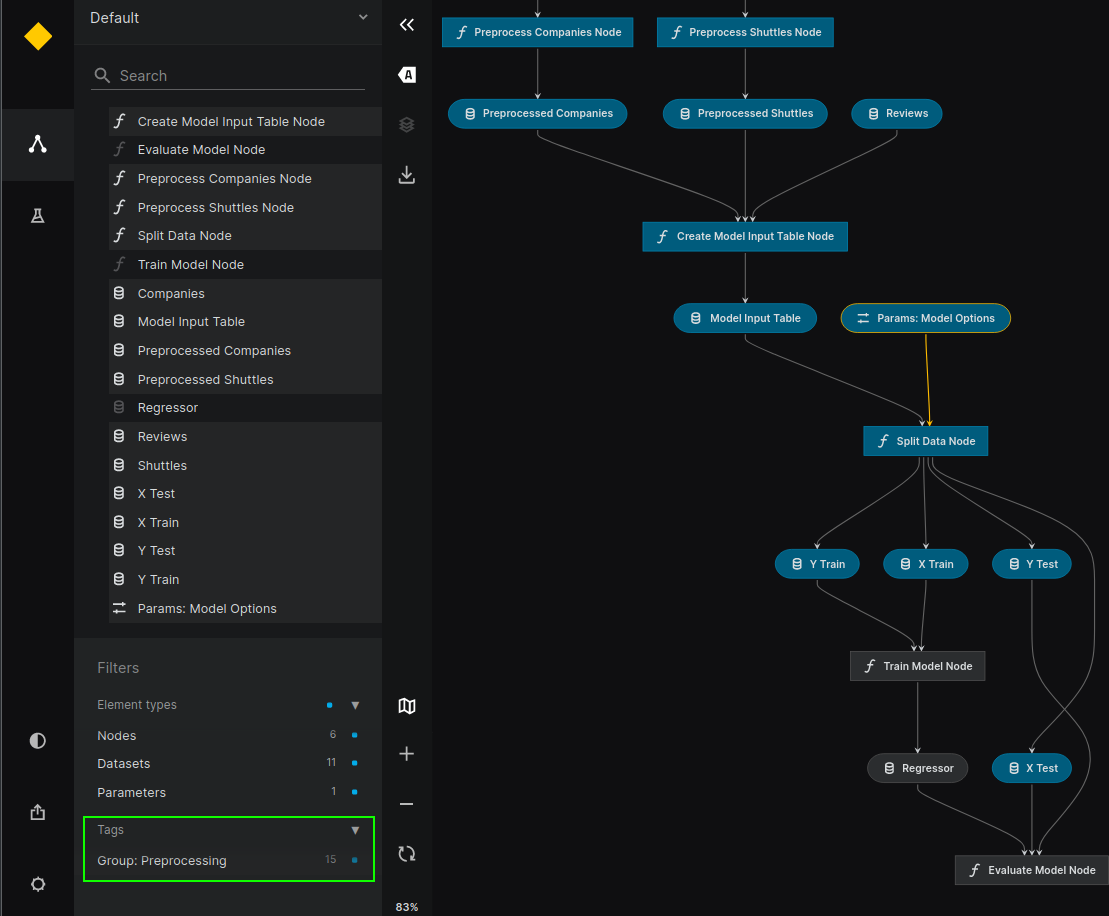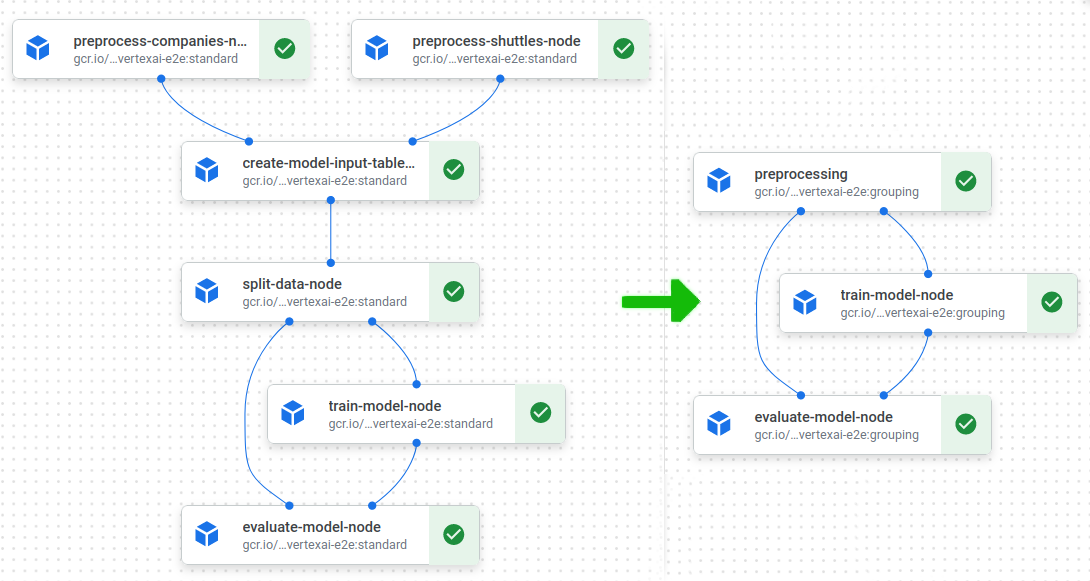Configuration
Plugin maintains the configuration in the conf/base/vertexai.yaml file. Sample configuration can be generated using kedro vertexai init:
# Configuration used to run the pipeline
project_id: my-gcp-mlops-project
region: europe-west1
run_config:
# Name of the image to run as the pipeline steps
image: eu.gcr.io/my-gcp-mlops-project/example_model:${oc.env:KEDRO_CONFIG_COMMIT_ID}
# Pull policy to be used for the steps. Use Always if you push the images
# on the same tag, or Never if you use only local images
image_pull_policy: IfNotPresent
# Location of Vertex AI GCS root
root: bucket_name/gcs_suffix
# Name of the kubeflow experiment to be created
experiment_name: MyExperiment
# Name of the scheduled run, templated with the schedule parameters
scheduled_run_name: MyExperimentRun
# Optional pipeline description
#description: "Very Important Pipeline"
# Optional config for node execution grouping. - 2 classes are provided:
# - default no-grouping option IdentityNodeGrouper
# - tag based grouping with TagNodeGrouper
grouping:
cls: kedro_vertexai.grouping.IdentityNodeGrouper
# cls: kedro_vertexai.grouping.TagNodeGrouper
# params:
# tag_prefix: "group."
# How long to keep underlying Argo workflow (together with pods and data
# volume after pipeline finishes) [in seconds]. Default: 1 week
ttl: 604800
# What Kedro pipeline should be run as the last step regardless of the
# pipeline status. Used to send notifications or raise the alerts
# on_exit_pipeline: notify_via_slack
# Optional section allowing adjustment of the resources, reservations and limits
# for the nodes. You can specify node names or tags to select which nodes the requirements
# apply to (also in node selectors). When not provided they're set to 500m cpu and 1024Mi memory.
# If you don't want to specify pipeline resources set both to None in __default__.
resources:
# For nodes that require more RAM you can increase the "memory"
data-import-node:
memory: 2Gi
# Training nodes can utilize more than one CPU if the algorithm
# supports it
model-training-node:
cpu: 8
memory: 60Gi
# GPU-capable nodes can request 1 GPU slot
tensorflow-node:
gpu: 1
# Resources can be also configured via nodes tag
# (if there is node name and tag configuration for the same
# resource, tag configuration is overwritten with node one)
gpu_node_tag:
cpu: 1
gpu: 2
# Default settings for the nodes
__default__:
cpu: 200m
memory: 64Mi
# Optional section allowing to configure node selectors constraints
# like gpu accelerator for nodes with gpu resources.
# (Note that not all accelerators are available in all
# regions - https://cloud.google.com/compute/docs/gpus/gpu-regions-zones)
# and not for all machines and resources configurations -
# https://cloud.google.com/vertex-ai/docs/training/configure-compute#specifying_gpus
node_selectors:
gpu_node_tag:
cloud.google.com/gke-accelerator: NVIDIA_TESLA_T4
tensorflow-step:
cloud.google.com/gke-accelerator: NVIDIA_TESLA_K80
# Optional section allowing to generate config files at runtime,
# useful e.g. when you need to obtain credentials dynamically and store them in credentials.yaml
# but the credentials need to be refreshed per-node
# (which in case of Vertex AI would be a separate container / machine)
# Example:
# dynamic_config_providers:
# - cls: kedro_vertexai.auth.gcp.MLFlowGoogleOAuthCredentialsProvider
# params:
# client_id: iam-client-id
dynamic_config_providers: []
Dynamic configuration support
The plugin relies on the project configuration and uses the same config loader that your project uses.
For some cases, you need to modify the settings.py to work with our plugin. Follow the instructions below.
Every Kedro Vertex AI job gets injected with two environment variables:
KEDRO_CONFIG_JOB_NAME- contains name of the job from Vertex AIKEDRO_CONFIG_RUN_ID- contains unique run identifier from Vertex AI
You can consume them as you like or use them within config loaders.
Using OmegaConfigLoader
In order to enable usage of environment variables with OmegaConfigLoader, update the settings.py file in your Kedro project as follows:
from kedro.config import OmegaConfigLoader
from omegaconf.resolvers import oc
CONFIG_LOADER_CLASS = OmegaConfigLoader
CONFIG_LOADER_ARGS = {
"custom_resolvers": { "oc.env": oc.env },
"config_patterns": {"vertexai": ["vertexai*"]}
# other args
}
Then in config you can use it in the following way. Important: oc.env:... can’t have space in it.
job: ${oc.env:KEDRO_CONFIG_JOB_NAME, default-value}
Follow Kedro’s official documentation, to see how to add templating, custom resolvers etc. (https://docs.kedro.org/en/stable/configuration/advanced_configuration.html#how-to-do-templating-with-the-omegaconfigloader)[https://docs.kedro.org/en/stable/configuration/advanced_configuration.html#how-to-do-templating-with-the-omegaconfigloader]
Dynamic config providers
When running the job in VertexAI it’s possible to generate new configuration files at runtime if that’s required, one example could be generating Kedro credentials on a Vertex AI’s node level (the opposite would be supplying the credentials when starting the job).
Example:
run_config:
# ...
dynamic_config_providers:
- cls: <fully qualified class name inheriting from kedro_vertexai.dynamic_config.DynamicConfigProvider>
params:
# ... params passed to the constructor of the class
abc: value1
xyz: value2
The cls fields should contain a fully qualified reference to a class implementing abstract kedro_vertexai.dynamic_config.DynamicConfigProvider. All params will be passed as kwargs to the class’s constructor.
Two required methods are:
@property
def target_config_file(self) -> str:
return "name-of-the-config-file.yml"
def generate_config(self) -> dict:
return {
"layout": {
"of-the-target": {
"config-file": "value"
}
}
}
First one - target_config_file should return the name of the configuration file to be generated (e.g. credentials.yml) and the generate_config should return a dictionary, which will be then serialized into the target file as YAML. If the target file already exists during the invocation, it will be merged (see method kedro_vertexai.dynamic_config.DynamicConfigProvider.merge_with_existing ) with the existing one and then saved again.
Note that the generate_config has access to an initialized plugin config via self.config property, so any values from the vertexai.yml configuration is accessible.
Grouping feature
Optional grouping section enables grouping feature that aggregates many Kedro nodes execution to single VertexAI node(s). Using it allows you to freely subdivide Kedro pipelines to as many steps as logically makes sense while keeping advantages of in memory data transmission possibilities. It also saves you a lot of time avoiding delays of docker container starting at Vertex nodes which can amount to about 2 minutes for each VertexAI node.
API allows implementation of your own aggregation method. You can provide aggregating class and its additional init params as kwargs dictionary. Default class is IdentitiyNodeGrouper which actually does not group the nodes (plugin behaves as in versions before 0.9.1). Class that implements grouping using configured tag prefix is called TagNodeGrouper. The default prefix is "group.". It uses what follows after the tag prefix as a name of group of nodes. Only one tag with this grouping prefix is allowed per node; more than that results in GroupingException. Example configuration:
grouping:
cls: kedro_vertexai.grouping.TagNodeGrouper
params:
tag_prefix: "group."
The above configuration will result in the following result in this sample pipeline:
Pipeline([
node(some_operation, "A", "B", name="node1", tags=["foo", "group.nodegroup"]),
node(some_operation, "B", "C", name="node2", tags=["bar", "group.nodegroup"]),
node(some_operation, "C", "D", name="node3", tags=["baz"]),
])
The result will be 2 VertexAI nodes for this pipeline, first with name nodegroup that will run node1 and node2 Kedro nodes inside and provide output C and second VertexAI node: node3. Additional MLflow node can be present if kedro-mlflow is used. Right now it is not possible to group it. If you feel you need that functionality search for/create an issue on github page of the plugin.
This grouping class is used during pipeline translation at plugin pipeline generator. It implements interface of NodeGrouper class with group function, that accepts pipeline.node_dependencies and returns Grouping. Grouping is a dataclass with two dictionaries:
node_mapping- which defines names of groups and says which sets of nodes are part of a given groupdependencies- which defines child-parent relation of all groups innode_mapping.Groupingclass also validates dependencies upon creation to check whether the grouping is valid. That means it does not introduce a cycle in dependencies graph.
Warning
Make sure that all nodes in pipeline have names and their names are unique within the pipeline when using this feature, as grouping class and VertexAI nodes naming depend on it.
Example
Here you can see how standard spaceflights changes after enabling the grouping feature configured with TagNodeGrouper, when using the following tagging (view from kedro viz):

We get the following result:

Resources configuration
Optional resources and node_selectors sections enable adjustment of the resources reservations and limits for the
selected Kedro nodes. Settings for individual nodes, we can define in two ways - using the name of the node or
its tag (if there is node name and tag configuration for the same resource, tag configuration is overwritten with
node one). For example, with the vertexai.yaml configuration file shown at the beginning of the chapter and the Kedro
pipeline containing such a node:
def create_pipeline(**kwargs):
return Pipeline(
[
node(
func=train_model,
inputs=["X_train", "y_train"],
outputs="regressor",
name="model_training_node",
tags="gpu_node_tag",
),
]
)
we expect this particular node to run with two NVIDIA_TESLA_T4 GPUs, eight CPUs, and memory allocated according to
the specified 60Gi limit. (Note that not all accelerators are available in all regions and not for all machines and
resources configurations)